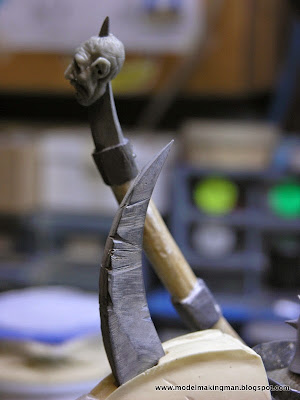We now start to see the figure more fully, with arms bulked up by Ferropre. The hands are rarely modelled as part of the arms but usually as part of what they are holding, in this case the axe. Because the axe will be held in front of the belly, the belly details must be finished before any hand work is undertaken. It is a real problem to get the order of the modelling tasks sorted out. Other non related bits, such as the trophy rack can now be started. This is the main element of the figure's back that is visible in the painting and my interpretation of it is based on the idea of a devotee of Nurgle, who's number is always three.
I made a mistake in building the rack like this even though I like it. It answers all the triple Nurgley questions, allowed itself to be attached in a sensible fashion (if a three pronged tree branch festooned with human heads can be called sensible) and was quite simple to make. The thing I didn't see until too late was the other branch tip just protruding through the centre of the hook attached to the shoulder guard. However it should have been, I used balsa, lead sheet and that hard grey "spike" plastic, to come up with my trophy rack.
An update picture showing all the finished bits. The axe is held on with Bluetack, as was the trophy rack, but the cauldron spike is in place and the whole thing is going well.
There are at least seven decapitated human heads in the painting, who knows how many more on the back? This necessitated casting from a master and manipulating the resin while soft to achieve a number of different looks. In the above picture, the masters are of Apoxie and are mounted on a support rod each while the copies are lighter. The blue stuff is a French product called Gedeo Siligum, which comes in two containers - one white, the other blue. Both are soft, rubbery, non sticky materials and you simply mix equal amounts until the colour is uniform. Into this you press your master, wait a few minutes and when the stuff feels firm, remove the master. I did this as well as using the pink two part mold and thus had more than enough heads. The pink molds are there to show the cut grooves for resin entry and air exit, as well as a new casting on the left and the master on the right. On the top of the spike is a scratch built head armature which will be built up to match the casts.
Pretty they aren't, but very necessary. The one on the right is as it came out of the mold, while the others have had things done to them while the resin was soft. I was thinking ahead (joke) and wrapped them with copper wire so that I would have a method securing them to the rack. Nurgle, being the chaos god of Disease, would appreciate the use of the black and white micro balls which look just like buboes, boils and skin eruptions. I found these when a foam rubber toy Stegosaurus split and spewed them all over the floor --they looked interesting and were immediately collected and stored.
As the modelling progressed, more detail was added such as the use of a large squared off syringe tip to impress into the putty as rivet heads at the margins of the armour plates.
Knee protectors came next, all spiked up as usual and with a border of thin solder to give that degree of 3D that you need to show.
At last a piece that looks human! Well maybe he was human once before he was blessed with the deadly kiss of Nurgle. Five toes even, but is that a spike growing out of his ankle? Too right and there's more of those to come.
Back to the top and you can see the battle damage on the spike as well as the finished unfortunate head impaled on the rack's spike.
You can see now how not attaching the axe and hands has allowed the front of the figure to develop. Below the belly is a belt, attached to which is the triple circled icon of Nurgle hanging over a chain mail and skin lap lap. The chain mail was made of looped fine solder, coiled around a skewer, pulled off and flattened in vertical rows. In there is a chain with a hook stabbed through the hanging skin lap lap. The skin was a piece of really old leather I had soaked in boiling water, hammered on an anvil until thin and holed and then cut to size and glued in place. I had become obsessed with emulating every skerrick of detail that I could see in the painting - there is a lot going on in an Adrian Smith painting.
By now the figure was in place, screwed securely onto its base, with both feet modelled around the attachment points as if he had walked up to the top of a hill. The greeves or leg protectors were in place nicely decked out with their due complement of spikes.
Next entry -- buckles, boils and hands.












No comments:
Post a Comment